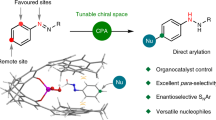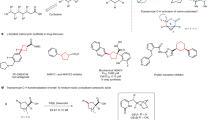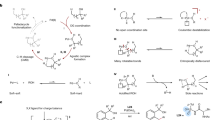Abstract
Achieving site selectivity in carbon–hydrogen (C–H) functionalization reactions is a long-standing challenge in organic chemistry. The small differences in intrinsic reactivity of C–H bonds in any given organic molecule can lead to the activation of undesired C–H bonds by a non-selective catalyst. One solution to this problem is to distinguish C–H bonds on the basis of their location in the molecule relative to a specific functional group. In this context, the activation of C–H bonds five or six bonds away from a functional group by cyclometallation has been extensively studied1,2,3,4,5,6,7,8,9,10,11,12,13. However, the directed activation of C–H bonds that are distal to (more than six bonds away) functional groups has remained challenging, especially when the target C–H bond is geometrically inaccessible to directed metallation owing to the ring strain encountered in cyclometallation14,15. Here we report a recyclable template that directs the olefination and acetoxylation of distal meta-C–H bonds—as far as 11 bonds away—of anilines and benzylic amines. This template is able to direct the meta-selective C–H functionalization of bicyclic heterocycles via a highly strained, tricyclic-cyclophane-like palladated intermediate. X-ray and nuclear magnetic resonance studies reveal that the conformational biases induced by a single fluorine substitution in the template can be enhanced by using a ligand to switch from ortho- to meta-selectivity.
This is a preview of subscription content, access via your institution
Access options
Subscribe to this journal
Receive 51 print issues and online access
$199.00 per year
only $3.90 per issue
Buy this article
- Purchase on Springer Link
- Instant access to full article PDF
Prices may be subject to local taxes which are calculated during checkout




Similar content being viewed by others
References
Engle, K. M., Mei, T.-S., Wasa, M. & Yu, J.-Q. Weak coordination as a powerful means for developing broadly useful C–H functionalization reactions. Acc. Chem. Res. 45, 788–802 (2012)
Hartung, C. G. & Snieckus, V. in Modern Arene Chemistry (ed. Astruc, D. ) 330–367 (Wiley-VCH, 2004)
Flemming, J. P., Berry, M. B. & Brown, J. M. Sequential ortho-lithiations; the sulfoxide group as a relay to enable meta-substitution. Org. Biomol. Chem. 6, 1215–1221 (2008)
Kakiuchi, F. et al. Catalytic addition of aromatic carbon–hydrogen bonds to olefins with the aid of ruthenium complexes. Bull. Chem. Soc. Jpn 68, 62–83 (1995)
Jun, C.-H., Hong, J.-B. & Lee, D.-Y. Chelation-assisted hydroacylation. Synlett 1–12 (1999)
Colby, D. A., Bergman, R. G. & Ellman, J. A. Rhodium-catalyzed C–C bond formation via heteroatom-directed C–H bond activation. Chem. Rev. 110, 624–655 (2010)
Daugulis, O., Do, H.-Q. & Shabashov, D. Palladium- and copper-catalyzed arylation of carbon–hydrogen bonds. Acc. Chem. Res. 42, 1074–1086 (2009)
Desai, L. V., Hull, K. L. & Sanford, M. S. Palladium-catalyzed oxygenation of unactivated sp3 C−H bonds. J. Am. Chem. Soc. 126, 9542–9543 (2004)
Satoh, T. & Miura, M. Oxidative coupling of aromatic substrates with alkynes and alkenes under rhodium catalysis. Chemistry 16, 11212–11222 (2010)
Guimond, N., Gorelsky, S. I. & Fagnou, K. Rhodium(III)-catalyzed heterocycle synthesis using an internal oxidant: improved reactivity and mechanistic studies. J. Am. Chem. Soc. 133, 6449–6457 (2011)
Rakshit, S., Grohmann, C., Besset, T. & Glorius, F. Rh(III)-catalyzed directed C–H olefination using an oxidizing directing group: mild, efficient, and versatile. J. Am. Chem. Soc. 133, 2350–2353 (2011)
Park, S. H., Kim, J. Y. & Chang, S. Rhodium-catalyzed selective olefination of arene esters via C–H bond activation. Org. Lett. 13, 2372–2375 (2011)
Ackermann, L. & Pospech, J. Ruthenium-catalyzed oxidative C–H bond alkenylations in water: expedient synthesis of annulated lactones. Org. Lett. 13, 4153–4155 (2011)
Leow, D., Li, G., Mei, T.-S. & Yu, J.-Q. Activation of remote meta-C–H bonds assisted by an end-on template. Nature 486, 518–522 (2012)
Wan, L., Dastbaravardeh, N., Li, G. & Yu, J.-Q. Cross-coupling of remote meta-C–H bonds directed by a U-shaped template. J. Am. Chem. Soc. 135, 18056–18059 (2013)
Schwarz, H. Remote functionalization of C–H and C–C bonds by naked transition-metal ions (cosi fan tutte). Acc. Chem. Res. 22, 282–287 (1989)
Breslow, R. Biomimetic control of chemical selectivity. Acc. Chem. Res. 13, 170–177 (1980)
Das, S., Incarvito, C. D., Crabtree, R. H. & Brudvig, G. W. Molecular recognition in the selective oxygenation of saturated C–H bonds by a dimanganese catalyst. Science 312, 1941–1943 (2006)
Boele, M. D. K. et al. Selective Pd-catalyzed oxidative coupling of anilides with olefins through C−H bond activation at room temperature. J. Am. Chem. Soc. 124, 1586–1587 (2002)
Paul, S., Schweizer, W. B., Ebert, M.-O. & Gilmour, R. A novel fluorinated gold(I) N-heterocyclic carbene complex: exploiting fluorine stereoelectronic effects to control molecular topology. Organometallics 29, 4424–4427 (2010)
Banks, J. W. et al. The preferred conformation of α-fluoroamides. J. Chem. Soc. Perkin Trans. 2 2409–2411 (1999)
Wang, D.-H., Engle, K. M., Shi, B.-F. & Yu, J.-Q. Ligand-enabled reactivity and selectivity in a synthetically versatile aryl C–H olefination. Science 327, 315–319 (2010)
Cho, J.-Y., Tse, M. K., Holmes, D., Maleczka, R. E., Jr & Smith, M. R., III Remarkably selective iridium catalysts for the elaboration of aromatic C–H bonds. Science 295, 305–308 (2002)
Ishiyama, T. et al. Mild iridium-catalyzed borylation of arenes. High turnover numbers, room temperature reactions, and isolation of a potential intermediate. J. Am. Chem. Soc. 124, 390–391 (2002)
Zhang, Y.-H., Shi, B.-F. & Yu, J.-Q. Pd(II)-catalyzed olefination of electron-deficient arenes using 2,6-dialkylpyridine ligands. J. Am. Chem. Soc. 131, 5072–5074 (2009)
Ye, M., Gao, G.-L. & Yu, J.-Q. Ligand-promoted C-3 selective C–H olefination of pyridines with Pd catalysts. J. Am. Chem. Soc. 133, 6964–6967 (2011)
Saidi, O. et al. Ruthenium-catalyzed meta-sulfonation of 2-phenylpyridines. J. Am. Chem. Soc. 133, 19298–19301 (2011)
Duong, H. A., Gilligan, R. E., Cooke, M. L., Phipps, R. J. & Gaunt, M. J. Copper(II)-catalyzed meta-selective direct arylation of α-aryl carbonyl compounds. Angew. Chem. Int. Ed. 50, 463–466 (2011)
Hull, K. L. & Sanford, M. S. Catalytic and highly regioselective cross-coupling of aromatic C−H substrates. J. Am. Chem. Soc. 129, 11904–11905 (2007)
Hofmann, N. & Ackermann, L. meta-Selective C–H bond alkylation with secondary alkyl halides. J. Am. Chem. Soc. 135, 5877–5884 (2013)
Acknowledgements
We gratefully acknowledge The Scripps Research Institute and the NIH (NIGMS, 1R01 GM102265) for their financial support. R.-Y.T. is a visiting scholar from Wenzhou University and is sponsored by the National Natural Science Foundation of China (21202121).
Author information
Authors and Affiliations
Contributions
R.-Y.T. and G.L. performed the experiments and developed the reactions. R.-Y.T. and J.-Q.Y. designed the templates. J.-Q.Y. had the idea for this work and prepared this manuscript with feedback from R.-Y.T. and G.L.
Corresponding author
Ethics declarations
Competing interests
The authors declare no competing financial interests.
Supplementary information
Supplementary Information
This file contains Supplementary Text and Data, Supplementary Figures and Supplementary Tables – see Contents for details. (PDF 36882 kb)
Rights and permissions
About this article
Cite this article
Tang, RY., Li, G. & Yu, JQ. Conformation-induced remote meta-C–H activation of amines. Nature 507, 215–220 (2014). https://doi.org/10.1038/nature12963
Received:
Accepted:
Published:
Issue Date:
DOI: https://doi.org/10.1038/nature12963
This article is cited by
-
Unlocking regioselective meta-alkylation with epoxides and oxetanes via dynamic kinetic catalyst control
Nature Communications (2024)
-
Tunably strained metallacycles enable modular differentiation of aza-arene C–H bonds
Nature Communications (2023)
-
Ruthenium(II)-enabled para-selective C–H difluoromethylation of anilides and their derivatives
Nature Communications (2018)
-
Remote C−H alkylation and C−C bond cleavage enabled by an in situ generated palladacycle
Nature Chemistry (2017)
-
Ruthenium(II)-catalysed remote C–H alkylations as a versatile platform to meta-decorated arenes
Nature Communications (2017)
Comments
By submitting a comment you agree to abide by our Terms and Community Guidelines. If you find something abusive or that does not comply with our terms or guidelines please flag it as inappropriate.



